The Weibull-Gamma Distribution: Properties and Applications
Abstract
:1. Introduction
2. The Weibull-Generated Family
3. The Weibull-Gamma Distribution
4. Some Special Cases of the Weibull-Gamma Distribution
- If , the W-g distribution reduces to the standard exponential distribution, with pdf as follows
- When in the W-g model, the gamma distribution in Equation (2) with shape parameter k and scale parameter s is obtained.
- If , the W-g distribution reduces to the exponential-gamma distribution, with pdf as followswhere and are, respectively, defined by Equation (4).
5. Properties
5.1. Useful Expansions
5.2. Quantile Function
5.3. Moments
5.4. Moment Generating Function
5.5. Characteristic Function
6. Parameter Estimation for Weibull-Gamma Distribution
7. Simulation Study
- Case I: , and
- Case II:
8. Applications
8.1. First Dataset
8.2. Second Dataset
8.3. Third Dataset
8.4. Fourth Dataset
8.5. Fifth Dataset
9. Conclusions
Funding
Conflicts of Interest
Abbreviations
| cdf | cumulative distribution function |
| probability density function | |
| RV | random variable |
| MLE | maximum likelihood estimator |
| W-G | Weibull-generated |
| W-g | Weibull-gamma |
| EG | exponentiated gamma |
| EE | exponentiated exponential |
| AIC | Akaike Information Criterion |
| RMSE | root mean squared error |
References
- Lee, C.; Famoye, F.; Alzaatreh, A.Y. Methods for generating families of univariate continuous distributions in the recent decades. Wiley Interdiscip. Rev. Comput. Stat. 2013, 5, 219–238. [Google Scholar] [CrossRef]
- Alzaatreh, A.; Lee, C.; Famoye, F. A new method for generating families of continuous distributions. Metron 2013, 71, 63–79. [Google Scholar] [CrossRef]
- Alzaatreh, A.; Famoye, F.; Lee, C. The gamma-normal distribution: Properties and applications. Comput. Stat. Data Anal. 2014, 69, 67–80. [Google Scholar] [CrossRef]
- Cordeiro, G.M.; Ortega, E.M.; Popović, B.V.; Pescim, R.R. The Lomax generator of distributions: Properties, minification process and regression model. Appl. Math. Comput. 2014, 247, 465–486. [Google Scholar] [CrossRef]
- Cakmakyapan, S.; Ozel, G. The Lindley family of distributions: Properties and applications. Hacet. J. Math. Stat. 2016, 46, 1–27. [Google Scholar] [CrossRef]
- Alizadeh, M.; Cordeiro, G.M.; Pinho, L.G.B.; Ghosh, I. The Gompertz-G family of distributions. J. Stat. Theory Pract. 2017, 11, 179–207. [Google Scholar] [CrossRef]
- Nasir, M.A.; Tahir, M.; Jamal, F.; Ozel, G. A new generalized Burr family of distributions for the lifetime data. J. Stat. Appl. Probab. 2017, 6, 401–417. [Google Scholar] [CrossRef]
- Hassan, A.S.; Nassr, S.G. Power Lindley-G Family of Distributions. In Annals of Data Science; Springer: Berlin/Heidelberg, Germany, 2018; pp. 1–22. [Google Scholar]
- Cordeiro, G.M.; Afify, A.Z.; Ortega, E.M.; Suzuki, A.K.; Mead, M.E. The odd Lomax generator of distributions: Properties, estimation and applications. J. Comput. Appl. Math. 2019, 347, 222–237. [Google Scholar] [CrossRef]
- Gupta, R.C.; Gupta, P.L.; Gupta, R.D. Modeling failure time data by Lehman alternatives. Commun. Stat. Theory Methods 1998, 27, 887–904. [Google Scholar] [CrossRef]
- Nadarajah, S.; Gupta, A.K. The exponentiated gamma distribution with application to drought data. Calcutta Stat. Assoc. Bull. 2007, 59, 29–54. [Google Scholar] [CrossRef]
- Alzaghal, A.; Famoye, F.; Lee, C. Exponentiated T-X family of distributions with some applications. Int. J. Stat. Probab. 2013, 2, 31. [Google Scholar] [CrossRef]
- Bourguignon, M.; Silva, R.B.; Cordeiro, G.M. The Weibull-G family of probability distributions. J. Data Sci. 2014, 12, 53–68. [Google Scholar]
- Nasiru, S.; Luguterah, A. The new weibull-pareto distribution. Pak. J. Stat. Oper. Res. 2015, 11, 103–114. [Google Scholar] [CrossRef]
- Tahir, M.; Zubair, M.; Mansoor, M.; Cordeiro, G.M.; Alizadeh, M.; Hamedani, G. A new Weibull-G family of distributions. Hacet. J. Math. Stat. 2016, 45, 629–647. [Google Scholar] [CrossRef]
- Alzaatreh, A.; Ghosh, I. On the Weibull-X family of distributions. J. Stat. Theory Appl. 2014, 14, 169–183. [Google Scholar]
- Cordeiro, G.M.; Ortega, E.M.; Ramires, T.G. A new generalized Weibull family of distributions: Mathematical properties and applications. J. Stat. Distrib. Appl. 2015, 2, 13. [Google Scholar] [CrossRef]
- Alzaatreh, A.; Famoye, F.; Lee, C. Weibull-Pareto distribution and its applications. Commun. Stat. Theory Methods 2013, 42, 1673–1691. [Google Scholar] [CrossRef]
- Ahmad, A.; Ahmad, S.; Ahmed, A. Characterization and Estimation of Weibull-Rayleigh Distribution with Applications to Life Time Data. Appl. Math. Inf. Sci. Lett. 2017, 5, 71–79. [Google Scholar] [CrossRef]
- Nadarajah, S.; Cordeiro, G.M.; Ortega, E.M. The Zografos–Balakrishnan-G family of distributions: Mathematical properties and applications. Commun. Stat. Theory Methods 2015, 44, 186–215. [Google Scholar] [CrossRef]
- Gradshteyn, I.S.; Ryzhik, I.M. Table of Integrals, Series, and Products; Academic Press: Cambridge, MA, USA, 2014. [Google Scholar]
- Gupta, R.D.; Kundu, D. Exponentiated exponential family: An alternative to gamma and Weibull distributions. Biom. J. J. Math. Methods Biosci. 2001, 43, 117–130. [Google Scholar] [CrossRef]
- Nadarajah, S.; Rocha, R. Newdistns: An R package for new families of distributions. J. Stat. Softw. 2016, 69, 1–32. [Google Scholar] [CrossRef]
- Akaike, H. A new look at the statistical model identification. IEEE Trans. Autom. Control 1974, 19, 716–723. [Google Scholar] [CrossRef]
- Meeker, W.Q.; Escobar, L.A. Statistical Methods for Reliability Data; John Wiley & Sons Inc.: New York, NY, USA, 1998. [Google Scholar]
- Aarset, M.V. How to identify a bathtub hazard rate. IEEE Trans. Reliab. 1987, 36, 106–108. [Google Scholar] [CrossRef]
- Pinho, L.G.B.; Cordeiro, G.M.; Nobre, J.S. The Harris extended exponential distribution. Commun. Stat. Theory Methods 2015, 44, 3486–3502. [Google Scholar] [CrossRef]
- Nassar, M.; Nada, N. The beta generalized Pareto distribution. J. Stat. Adv. Theory Appl. 2011, 6, 1–17. [Google Scholar]

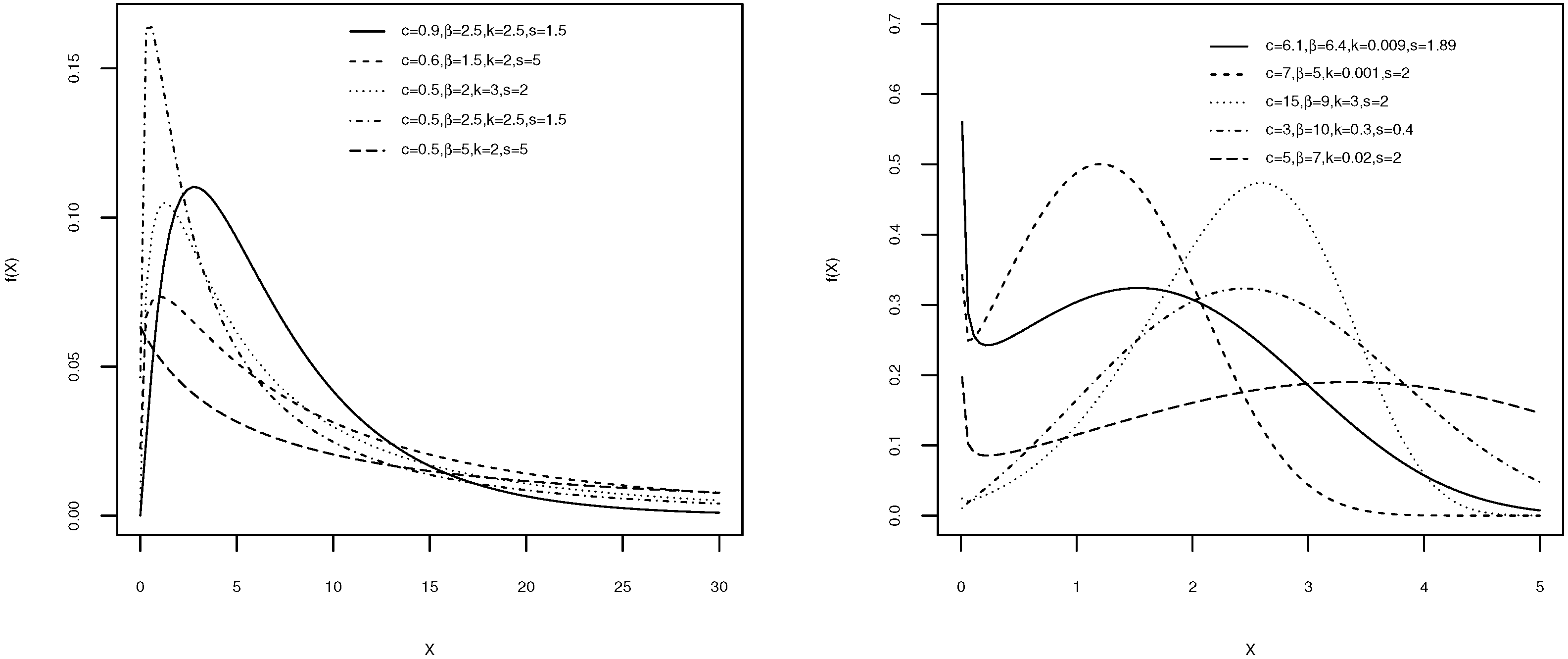
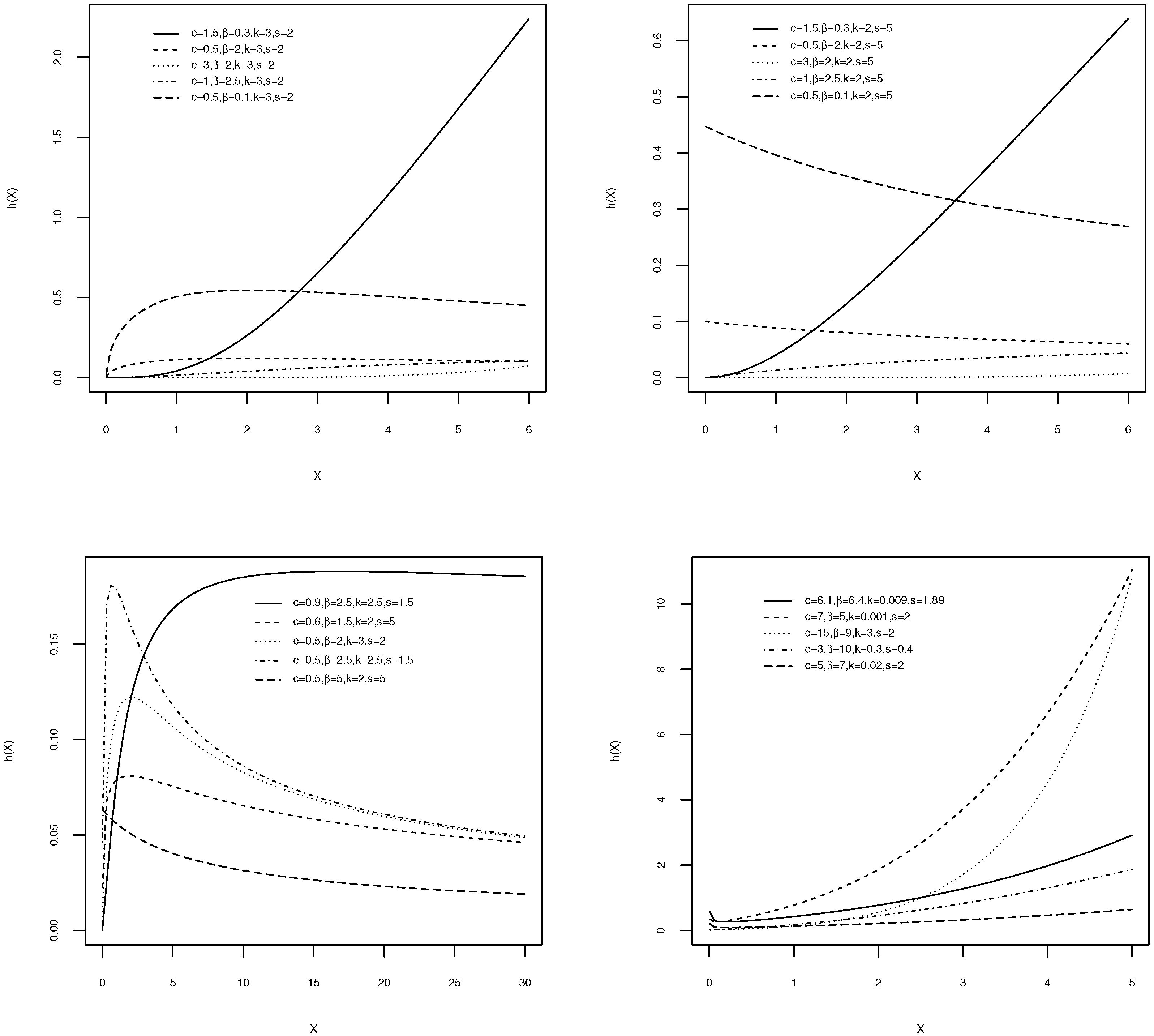
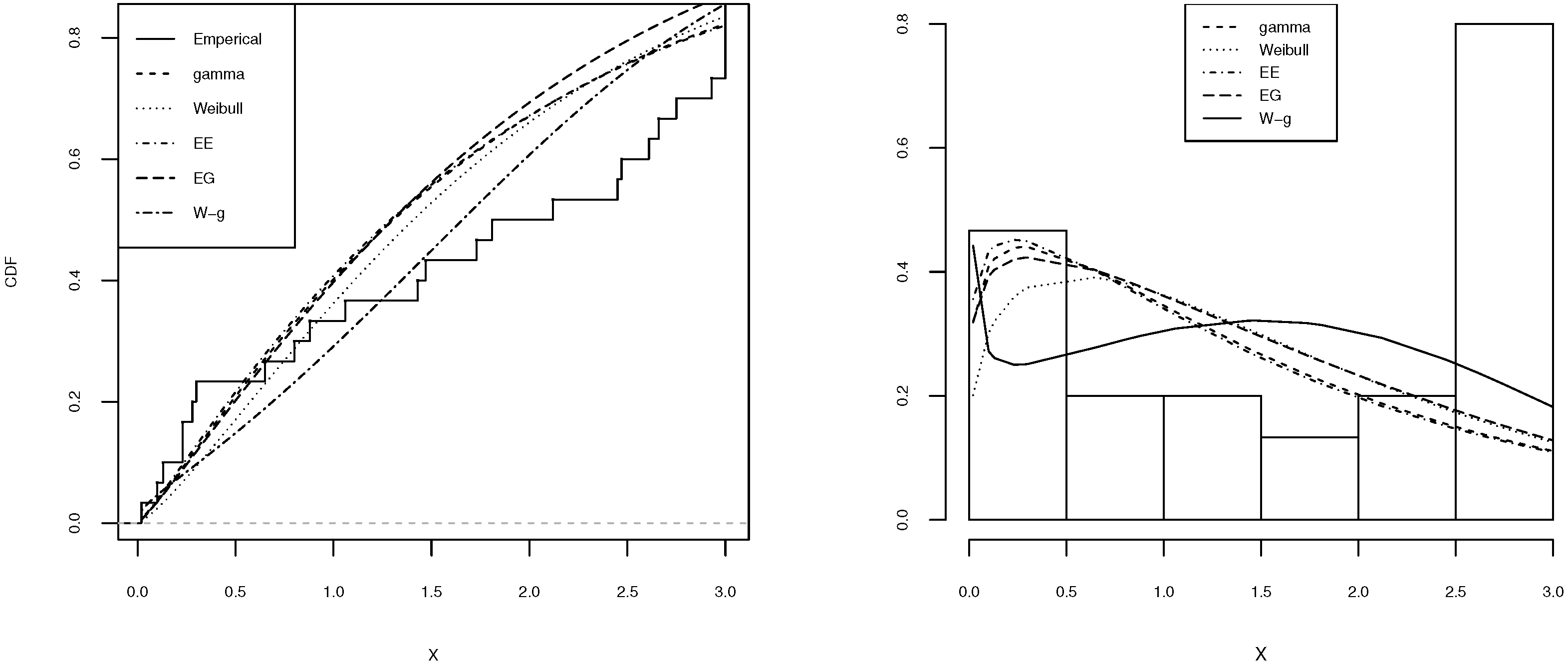
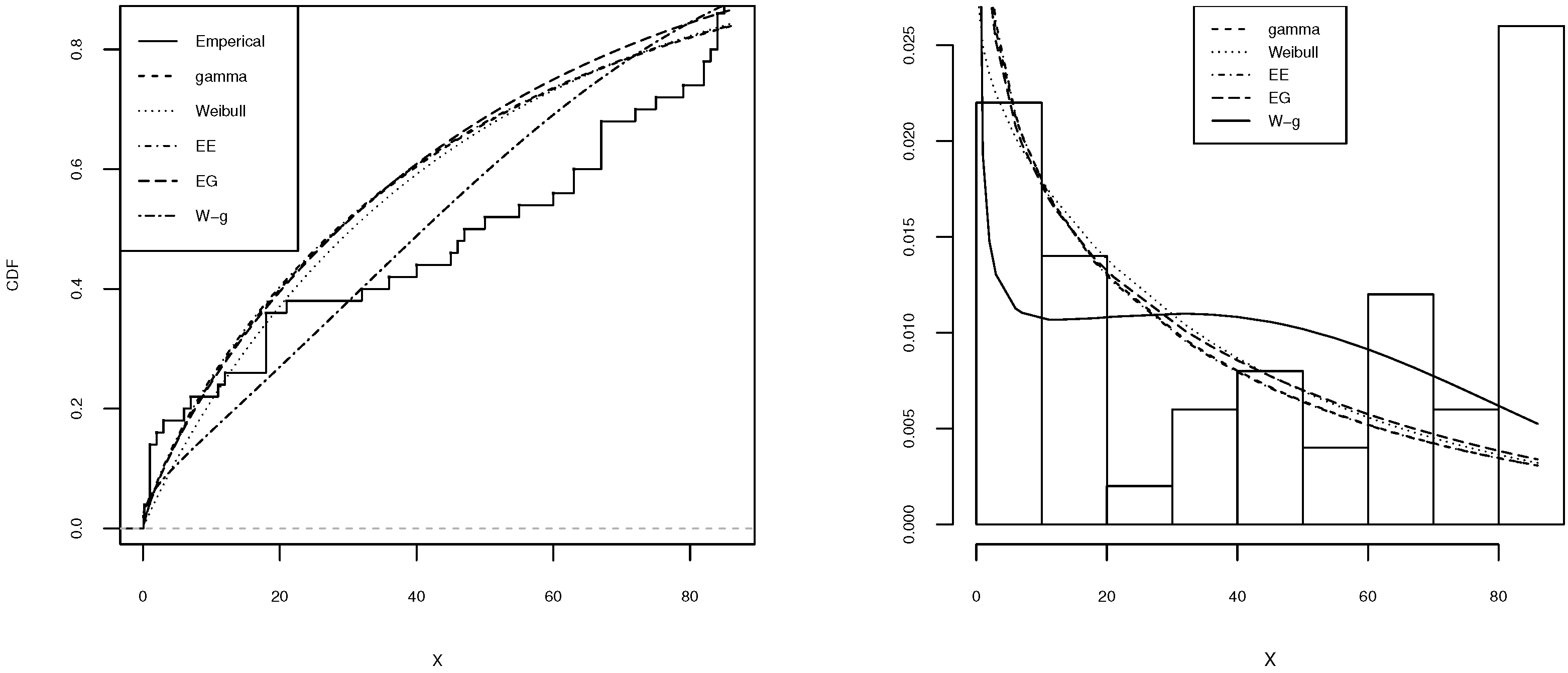
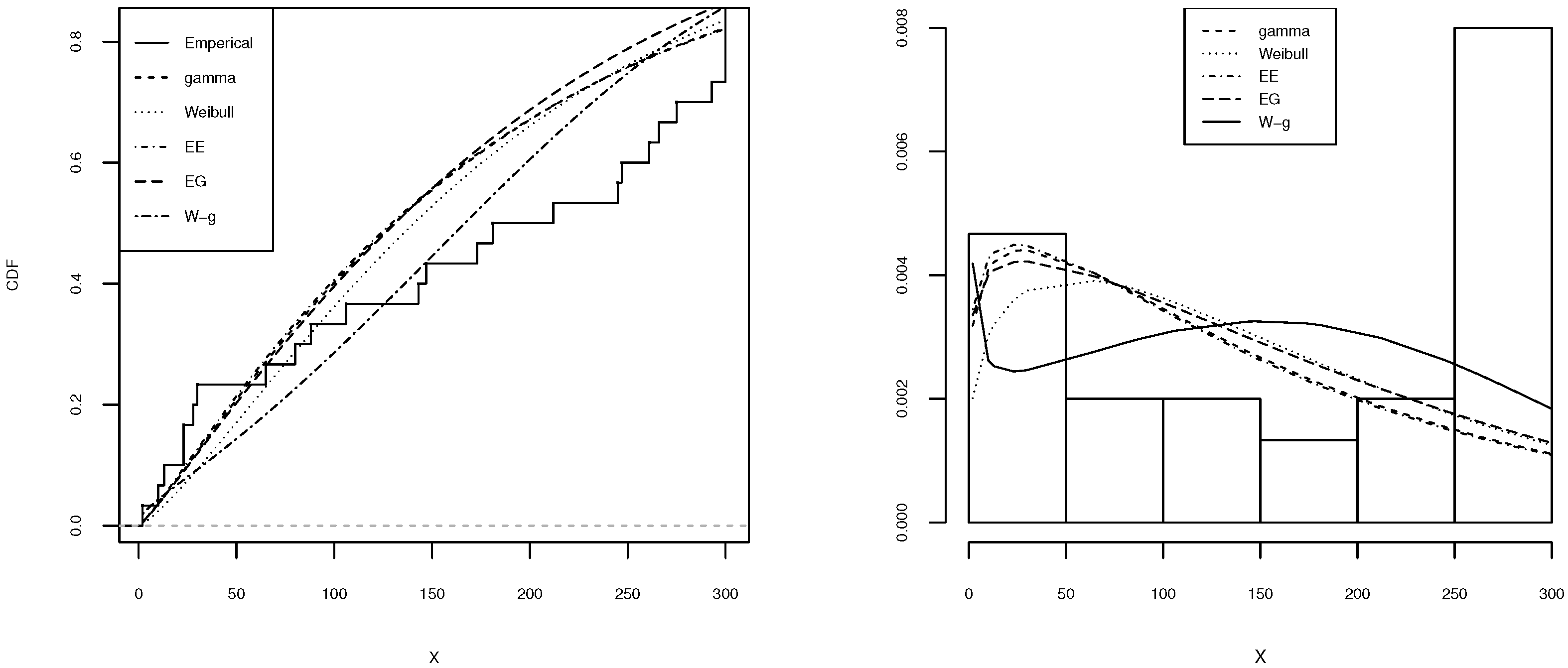
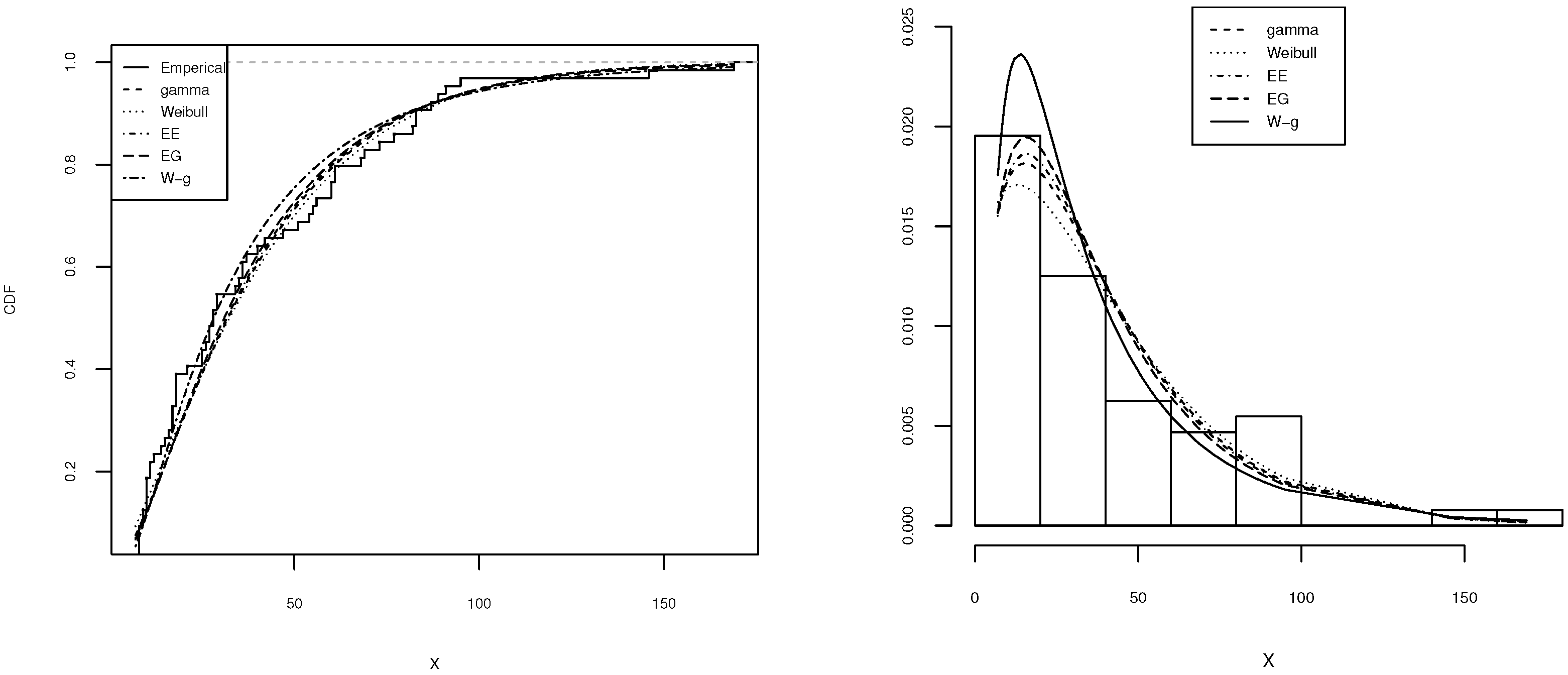
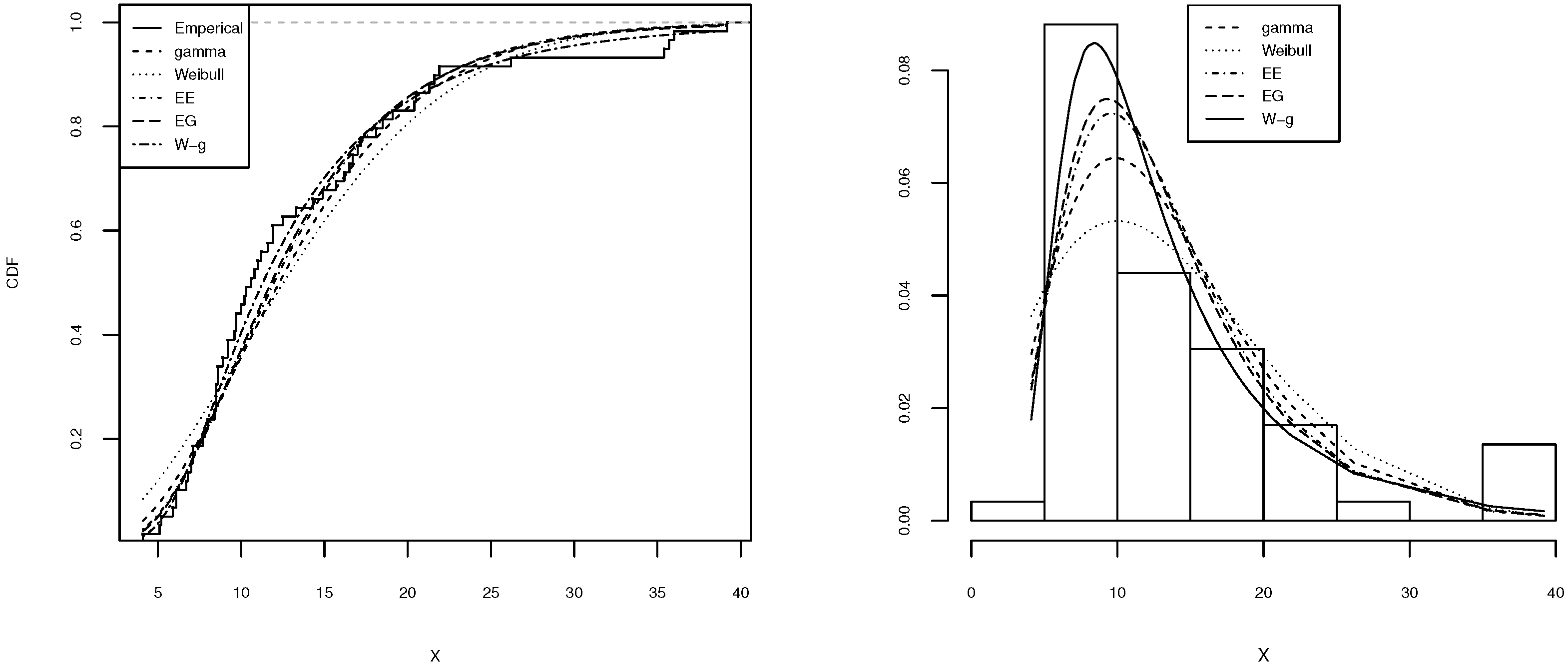
| Sample Size | Parameter | Case I | Case II | ||||
|---|---|---|---|---|---|---|---|
| MLE | Bias | RMSE | MLE | Bias | RMSE | ||
| c | 1.8567 | 0.3567 | 1.3371 | 2.4955 | 0.6955 | 1.8919 | |
| 0.9846 | 0.4846 | 1.2006 | 0.8371 | 0.5371 | 1.1462 | ||
| k | 0.8473 | 0.3473 | 0.9991 | 0.7038 | 0.2038 | 0.7729 | |
| s | 0.3492 | −0.0508 | 1.0025 | 0.3349 | −0.0651 | 0.9125 | |
| c | 1.6269 | 0.1269 | 0.8466 | 1.9732 | 0.1732 | 1.0898 | |
| 0.7970 | 0.2970 | 0.8186 | 0.5303 | 0.2303 | 0.6201 | ||
| k | 0.6396 | 0.1396 | 0.5129 | 0.6788 | 0.1788 | 0.5824 | |
| s | 0.4629 | 0.0629 | 0.9147 | 0.3931 | −0.0069 | 0.8175 | |
| c | 1.5168 | 0.0168 | 0.4565 | 1.7818 | −0.0182 | 0.4919 | |
| 0.7535 | 0.2535 | 0.7530 | 0.3760 | 0.0760 | 0.2767 | ||
| k | 0.5373 | 0.0373 | 0.2011 | 0.5534 | 0.0534 | 0.2481 | |
| s | 0.4577 | 0.0577 | 0.4976 | 0.4053 | 0.0053 | 0.4096 | |
| Distribution | gamma | Weibull | EE | EG | W-g |
|---|---|---|---|---|---|
| Parameter estimates | |||||
| Log-likelihood | −46.8656 | −46.1587 | −46.9569 | −44.3009 | −42.1281 |
| AIC | 97.7311 | 96.3175 | 97.9139 | 94.6018 | 92.2563 |
| Distribution | gamma | Weibull | EE | EG | W-g |
|---|---|---|---|---|---|
| Parameter estimates | |||||
| Log-likelihood | −240.1902 | −241.0018 | −239.9952 | −237.314 | −231.7916 |
| AIC | 484.3804 | 486.0037 | 483.9903 | 480.628 | 471.5832 |
| Distribution | gamma | Weibull | EE | EG | W-g |
|---|---|---|---|---|---|
| Parameter estimates | |||||
| Log-likelihood | −185.0207 | −184.3138 | −185.113 | −182.4996 | −180.267 |
| AIC | 374.0413 | 372.6277 | 374.2259 | 370.9992 | 368.5341 |
| Distribution | gamma | Weibull | EE | EG | W-g |
|---|---|---|---|---|---|
| Parameter estimates | |||||
| Log-likelihood | −295.8994 | −296.9001 | −295.666 | −295.2987 | −293.5914 |
| AIC | 595.7988 | 597.8003 | 595.332 | 596.5974 | 595.1828 |
| Distribution | gamma | Weibull | EE | EG | W-g |
|---|---|---|---|---|---|
| Parameter estimates | |||||
| Log-likelihood | −193.0820 | −197.2905 | −191.2235 | −190.3999 | −188.3944 |
| AIC | 390.164 | 398.5811 | 386.4471 | 386.7998 | 384.7887 |
© 2019 by the author. Licensee MDPI, Basel, Switzerland. This article is an open access article distributed under the terms and conditions of the Creative Commons Attribution (CC BY) license (http://creativecommons.org/licenses/by/4.0/).
Share and Cite
Klakattawi, H.S. The Weibull-Gamma Distribution: Properties and Applications. Entropy 2019, 21, 438. https://doi.org/10.3390/e21050438
Klakattawi HS. The Weibull-Gamma Distribution: Properties and Applications. Entropy. 2019; 21(5):438. https://doi.org/10.3390/e21050438
Chicago/Turabian StyleKlakattawi, Hadeel S. 2019. "The Weibull-Gamma Distribution: Properties and Applications" Entropy 21, no. 5: 438. https://doi.org/10.3390/e21050438
APA StyleKlakattawi, H. S. (2019). The Weibull-Gamma Distribution: Properties and Applications. Entropy, 21(5), 438. https://doi.org/10.3390/e21050438





